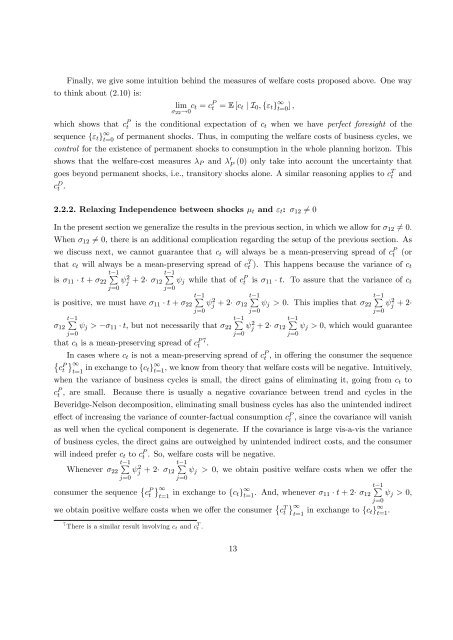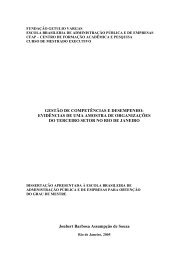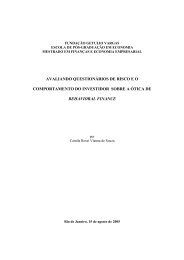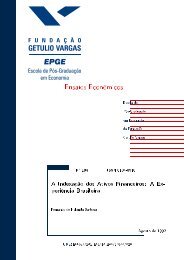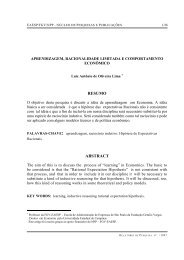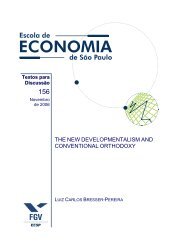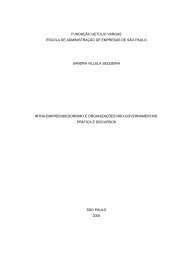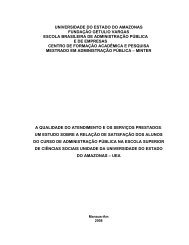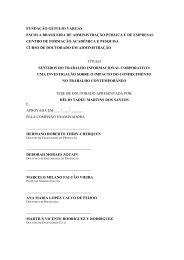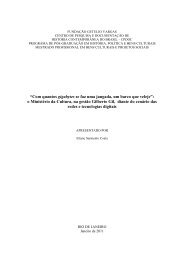Ensaios Econômicos - Sistema de Bibliotecas da FGV - Fundação ...
Ensaios Econômicos - Sistema de Bibliotecas da FGV - Fundação ...
Ensaios Econômicos - Sistema de Bibliotecas da FGV - Fundação ...
You also want an ePaper? Increase the reach of your titles
YUMPU automatically turns print PDFs into web optimized ePapers that Google loves.
Finally, we give some intuition behind the measures of welfare costs proposed above. One way<br />
to think about (2.10) is:<br />
lim c t = c P t = E [c t j I 0 ; f" t g 1<br />
22 !0<br />
t=0 ] ;<br />
which shows that c P t is the conditional expectation of c t when we have perfect foresight of the<br />
sequence f" t g 1 t=0<br />
of permanent shocks. Thus, in computing the welfare costs of business cycles, we<br />
control for the existence of permanent shocks to consumption in the whole planning horizon. This<br />
shows that the welfare-cost measures P and 0 P<br />
(0) only take into account the uncertainty that<br />
goes beyond permanent shocks, i.e., transitory shocks alone. A similar reasoning applies to c T t and<br />
c D t .<br />
2.2.2. Relaxing In<strong>de</strong>pen<strong>de</strong>nce between shocks t and " t : 12 6= 0<br />
In the present section we generalize the results in the previous section, in which we allow for 12 6= 0.<br />
When 12 6= 0, there is an additional complication regarding the setup of the previous section. As<br />
we discuss next, we cannot guarantee that c t will always be a mean-preserving spread of c P t<br />
that c t will always be a mean-preserving spread of c T t ). This happens because the variance of c t<br />
tP<br />
1<br />
is 11 t + <br />
2 22 j + 2 tP<br />
1<br />
12 j while that of c P t is 11 t. To assure that the variance of c t<br />
j=0<br />
j=0<br />
tP<br />
1<br />
is positive, we must have 11 t + 22<br />
tP<br />
1<br />
12<br />
j=0<br />
j=0<br />
2<br />
j + 2 12<br />
tP<br />
1<br />
j > 11 t, but not necessarily that 22<br />
that c t is a mean-preserving spread of c P t 7 .<br />
j=0<br />
tP<br />
1<br />
j=0<br />
2<br />
tP<br />
1<br />
j > 0. This implies that 22<br />
j + 2 12<br />
tP<br />
1<br />
j=0<br />
j=0<br />
(or<br />
2<br />
j + 2<br />
j > 0, which would guarantee<br />
In cases where c t is not a mean-preserving spread of c P t , in o¤ering the consumer the sequence<br />
<br />
c<br />
P 1<br />
t t=1 in exchange to fc tg 1 t=1<br />
, we know from theory that welfare costs will be negative. Intuitively,<br />
when the variance of business cycles is small, the direct gains of eliminating it, going from c t to<br />
c P t , are small.<br />
Because there is usually a negative covariance between trend and cycles in the<br />
Beveridge-Nelson <strong>de</strong>composition, eliminating small business cycles has also the uninten<strong>de</strong>d indirect<br />
e¤ect of increasing the variance of counter-factual consumption c P t , since the covariance will vanish<br />
as well when the cyclical component is <strong>de</strong>generate. If the covariance is large vis-a-vis the variance<br />
of business cycles, the direct gains are outweighed by uninten<strong>de</strong>d indirect costs, and the consumer<br />
will in<strong>de</strong>ed prefer c t to c P t . So, welfare costs will be negative.<br />
tP<br />
1<br />
Whenever <br />
2 22 j + 2 tP<br />
1<br />
12 j > 0, we obtain positive welfare costs when we o¤er the<br />
j=0<br />
consumer the sequence c P t<br />
j=0<br />
1<br />
t=1 in exchange to fc tg 1 t=1 . And, whenever tP<br />
1<br />
11 t + 2 12<br />
we obtain positive welfare costs when we o¤er the consumer c T t<br />
7 There is a similar result involving c t and c T t .<br />
j=0<br />
1<br />
t=1 in exchange to fc tg 1 t=1 .<br />
j > 0,<br />
13


